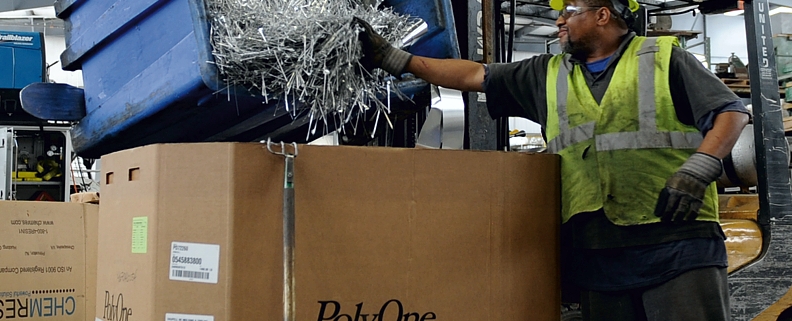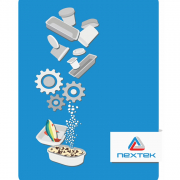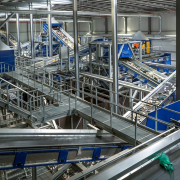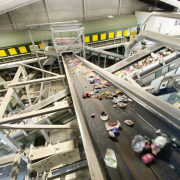Exploring the Changes in Scrap Metal Sorting
According to a 2017 report from the Institute of Scrap Recycling Industries (ISRI), the United States recycles 150 million metric tons of scrap materials annually. This volume includes 85 million tons of iron and steel, 5.5 million tons of aluminum, 1.8 million tons of copper, two million tons of stainless steel, 1.2 million tons of lead and 420,000 tons of zinc each year.
The recycled materials that the scrap metal industry sort and processes into raw material feedstock are crucial for industrial manufacturing around the world. For example, the proportion of recycled copper, found in electric wires and pipes used by the home building industry surpasses 50 percent according to Thought Co., The Benefits of Metal Recycling.
The nature of scrap metal sorting is changing. As any recycler will report, traditional scrap metal sorting techniques are becoming outdated. New techniques are required by the industry to efficiently process the huge volume of scrap that is received from both commercial and domestic sources. These changes have brought with them new challenges, which has fueled the demand for more effective tools that have the capabilities to increase the accuracy and speed of scrap metal identification. The increase of speed is vital to the profitability of businesses in this industry due to the fluctuation of metals prices.
Sullivan Scrap and its service challenges
Founded in 1953, and based in Holyoke (Massachusetts, USA), Sullivan Scrap partners with a broad range of customers requiring the recycling of scrap metal – including some of the region’s largest manufacturers – down to local individuals in and around New England. The company has created a reputation in the industry for providing customers with the fairest pricing for their scrap, in addition to offering over 50 years of expertise in effective and convenient solutions for handling and disposing of scrap metal materials.
Customers include both large-scale manufacturers, for example, someone in construction or demolition, and small-scale ‘do-it-your selfers’ looking to remove scrap metal from a garage, shed, or basement or old farm equipment. The removal and disposal of metal products and materials require expertise that will ensure that all unwanted metal products and materials are handled and disposed of safely and with minimal impact on the environment.
Customers of Sullivan Scrap require both speed and accuracy in the identification of an increasingly complex range of metals. Using ‘older’ generation metal identification instruments has become limiting to the scrap industry. Organizations in the scrap arena require a rapid throughput of metals to maximize potential profits. In many cases, existing analytical devices are cumbersome and not ideally suited to the typical scrap yard environment, making them potentially unreliable. Failure to rapidly identify all alloying elements can mean a missed opportunity for both speed and profit gain.
Meeting requirements head-on
Sullivan Scrap processes approximately 70,000 tons of materials each year, with 25 percent being non-ferrous metals like aluminum, copper and brass. In order to stay competitive, they use different handheld technologies to identify their incoming material in order to process it as efficiently as possible. Handheld analyzers are now the instrument of choice for the purpose of meeting the rigorous demands of modern scrap recycling. They can provide accurate alloy grade identification on-site for fast separation. The company has been using handheld x-ray fluorescence (XRF) technology for many years, typically for the analysis of nickel alloys, brasses, and other metals made up of heavier elements. However they found a gap in this technique when it came to processing lighter alloys, such as aluminum.
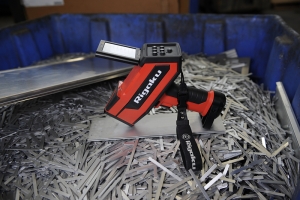
A key feature of the KT-100 is its ease of use for the everyday user (Photo: Rigaku Analytical Devices)
The company discovered laser-induced breakdown spectroscopy (LIBS) technology two years ago. This new generation handheld device has proven to be extremely effective in light elemental analysis – especially for aluminum – as well as having the capability of sorting heavier metals. Sullivan Scrap uses a LIBS device from Rigaku Analytical Devices called the KT-100 Series metal analyzer. The LIBS handheld device offers increased speed in obtaining analytical results, therefore allowing their facility to sort more alloys. In doing so, the scrap recycler is able to sort specific alloys out so they are not making a mixed package. This enhancement has allowed the firm to upgrade the materials that it is able to prepare and thus increase profitability on every pound. In addition to the analytical performance of LIBS technology, utilizing a laser-based technology reduces the need for regulatory licensing and registration that previous generation analyzers were susceptible to.
Sullivan Scrap found that a key feature of the KT-100 was its ease of use for the everyday user. The user is able to select what information is available on the results’ screen and is able to determine what is displayed, whether it is the spectra, the chemistry breakdown, or even just the alloy match name. The other stand-out features of the device are the hard, raised buttons on the keyboard. Other handheld analyzers are moving towards a touch screen operation only, which could become problematic for users who are wearing work gloves. Unlike other handheld devices used by the scrap recycler, the KT-100 has a docking station cradle that will charge the analyzer plus a spare battery at the same time. The cradle facility removes the need to take the battery out of the analyzer at the end of each shift, offering the advantage of being constantly ready to use on demand.
The environment at a scrap metal sorting facility is not ideal for analytical technology instruments. Therefore, any tool used to sort metal needs to be able to withstand the toughest use to ensure any unplanned downtime for the scrap yard and the associated repair costs avoided. The KT-100 Series LIBS analyzer has proved to be durable for use in tough environments, as it has passed rigorous U.S. Military 810-G certification for temperature, mechanical and drops testing, making it ideal for use in scrap yards.
Conclusions
Handheld LIBS technology has been in use at Sullivan Scrap for two years and has proved to make the sorting process quick and efficient, while the results from the device are reliable and consistent. The device is capable of the precise identification technology required to ensure the accurate resale value of both light and base metals allowing the opportunity for profit gain. With the use of LIBS technology, Sullivan Scrap has been able to meet the demands of modern scrap metal sorting.
www.rigaku.com/en/techniques/libs
Author: Jen Lynch – Marketing Director, Rigaku Analytical Devices
Photo: Rigaku Analytical Devices
GR12018

